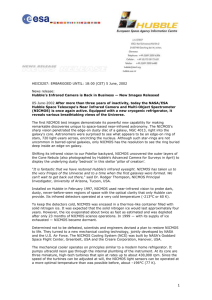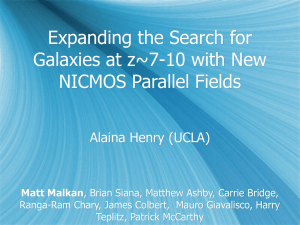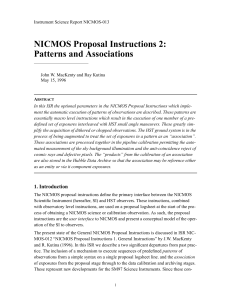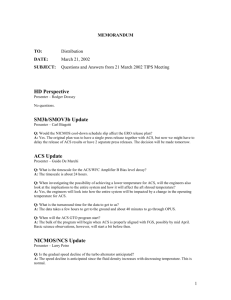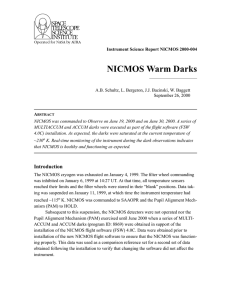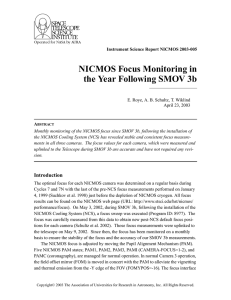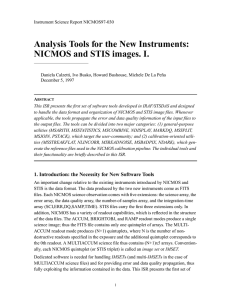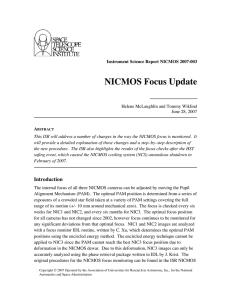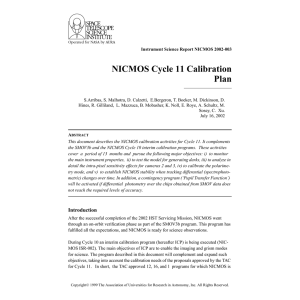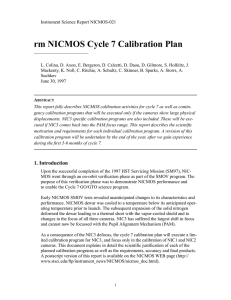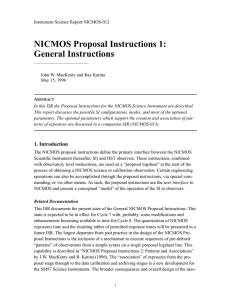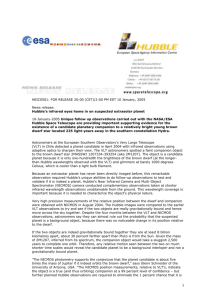NICMOS Phase 2 Proposal Examples.
advertisement
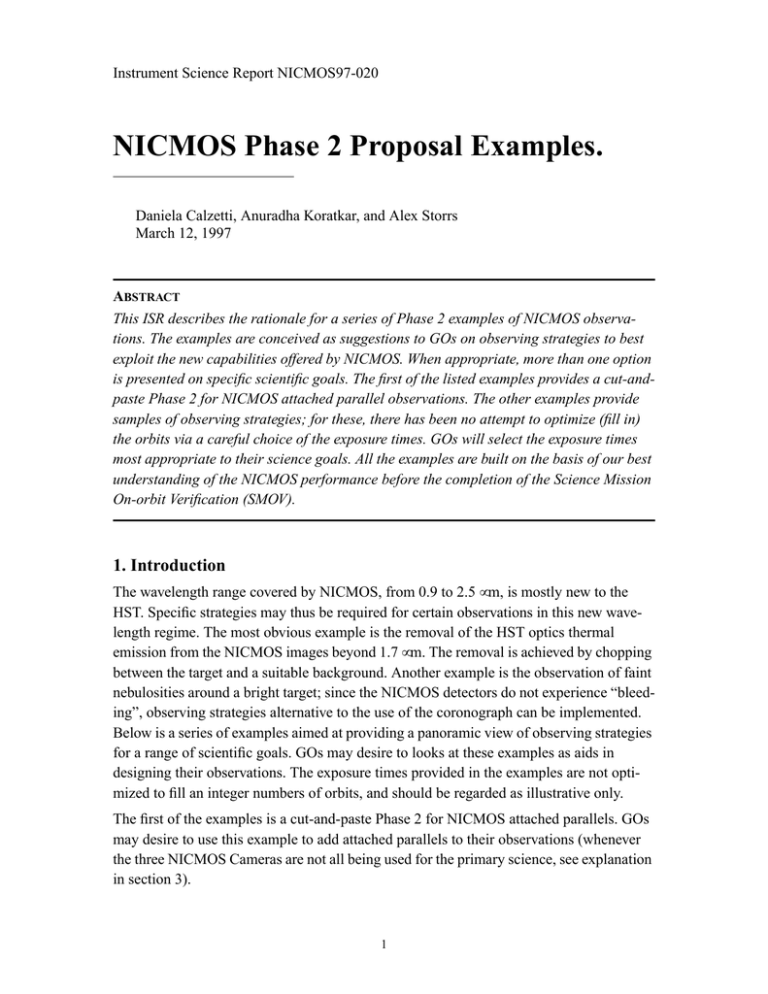
Instrument Science Report NICMOS97-020 NICMOS Phase 2 Proposal Examples. Daniela Calzetti, Anuradha Koratkar, and Alex Storrs March 12, 1997 ABSTRACT This ISR describes the rationale for a series of Phase 2 examples of NICMOS observations. The examples are conceived as suggestions to GOs on observing strategies to best exploit the new capabilities offered by NICMOS. When appropriate, more than one option is presented on specific scientific goals. The first of the listed examples provides a cut-andpaste Phase 2 for NICMOS attached parallel observations. The other examples provide samples of observing strategies; for these, there has been no attempt to optimize (fill in) the orbits via a careful choice of the exposure times. GOs will select the exposure times most appropriate to their science goals. All the examples are built on the basis of our best understanding of the NICMOS performance before the completion of the Science Mission On-orbit Verification (SMOV). 1. Introduction The wavelength range covered by NICMOS, from 0.9 to 2.5 µm, is mostly new to the HST. Specific strategies may thus be required for certain observations in this new wavelength regime. The most obvious example is the removal of the HST optics thermal emission from the NICMOS images beyond 1.7 µm. The removal is achieved by chopping between the target and a suitable background. Another example is the observation of faint nebulosities around a bright target; since the NICMOS detectors do not experience “bleeding”, observing strategies alternative to the use of the coronograph can be implemented. Below is a series of examples aimed at providing a panoramic view of observing strategies for a range of scientific goals. GOs may desire to looks at these examples as aids in designing their observations. The exposure times provided in the examples are not optimized to fill an integer numbers of orbits, and should be regarded as illustrative only. The first of the examples is a cut-and-paste Phase 2 for NICMOS attached parallels. GOs may desire to use this example to add attached parallels to their observations (whenever the three NICMOS Cameras are not all being used for the primary science, see explanation in section 3). 1 The other 7 examples cover a range of observing situations and techniques: imaging of faint and bright targets, grism observations, coronography, and polarimetry; presence/ absence of thermal background; dithering, both as a method to remove thermal background and for improving the image resolution; detection of faint nebulosities around bright targets, with and without the coronographic spot; use of the MULTIACCUM readout mode versus the ACCUM readout mode; use of the pre-defined MULTIACCUM sequences; use of the chop/dither PATTERNs and of PATTERN-ORIENT. In the next sections, we give the list of the examples and where to find them, together with a description of each example and its purpose. 2. Phase 2 Proposal Examples. The 8 Phase 2 examples are posted in the NICMOS WWW page at the address: http://www.stsci.edu/ftp/instrument_news/NICMOS/nicmos_propres_eg.html. This page can be reached from the NICMOS Top Page: http://www.stsci.edu/ftp/instrument_news/NICMOS/topnicmos.html, under ADVISORIES, DOCUMENTATION, and PROPOSAL RESOURCES. The examples are: 1. Proposal 1066. NICMOS Attached Parallels. 2. Proposal 1001. NICMOS Deep Field Observations. 3. Proposal 1011. NICMOS Imaging of Nearby Galaxies. 4. Proposal 1022. NICMOS Imaging of a Bright Stars Region. 5. Proposal 1033. NICMOS Imaging of Circumstellar Material 6. Proposal 1044. NICMOS Grism Observations. 7. Proposal 1055. NICMOS Coronographic Observations. 8. Proposal 1077. NICMOS Polarimetry of a Jet. 3. Attached Parallels As described in the NICMOS Handbook (pp. 27-28) and in the Phase 2 Update, proposers are asked to add attached parallels to their NICMOS primary observations, whenever this does not affect the primary science. Attached parallels are defined as observations in the two NICMOS cameras which are not used for the primary science. Some proposers may have already requested the use of all three Cameras for their science, but some others may have not (i.e., only one Camera is needed for their science). Those who didn’t, should fol- 2 low the guidelines given in the Handbook and the Phase 2 Update. It should be kept in mind that there is the potential for the three NICMOS Cameras to come back to parfocality once in orbit. Since attached parallels will be most useful when long integration times are available, the recommendation is to add attached parallels whenever the exposure times in the prime Camera are LONGER than 10 minutes at EACH fixed telescope pointing. The example of how the attached parallels should be structured is given below. The first visit shows the implementation of attached parallels for observations of extragalactic and Galactic Plane targets (see the Handbook); in this case broad band filters should be used. The second visit shows the implementation of attached parallels for observations of Molecular Clouds which use less than 4 orbits; for this case, narrow band filters should be used (for more than 4 orbits, broad band filters will be used). For illustrative purposes, in the first visit NIC2 is the primary Camera; in the second visit NIC1 is primary. The suggested readout mode is MULTIACCUM, with the sequence SPARSE256, in all cases. IMPORTANT: In general, users will define a Generic Target (see below) for the NICMOS attached parallels. In this way, they will not need to specify a value of the ORIENT for the pointings of the parallel detectors. The same Generic Target can be used for all exposures and all visits in the proposal. The specification of the Generic Target is not needed when the primary observation already requires an ORIENT. Proposers are encouraged to process through RPS2 their primary proposal, BEFORE adding the attached parallels, to ensure that the efficiency of the observations is not affected by the subsequent addition of attached parallels. Below we give the detailed Phase 2 for this example. The Phase 2 Fixed_Targets Target_Number: 1 Target_Name: HDF Alternate_Names: Hubble,Deep Description: GALAXY,PROTOGALAXY Position: RA=12H 36M 49.40S +/- 0.02S,DEC=62D 10’ 58.0” +/- 0.7” Equinox: J2000 RV_or_Z: RA_PM: 0.0 Dec_PM: 0.0 Epoch: Annual_Parallax: 0.0 3 Flux: F(1.60)=0.00 Comments: The value of the flux is in units of Jy, at 1.6 microns Target_Number: 2 Target_Name: MC Alternate_Names: Molecular,Cloud Description: ISM Position: RA=14H 36M 49.40S +/- 0.02S,DEC=02D 10’ 58.0” +/- 0.7” Equinox: J2000 RV_or_Z: RA_PM: 0.0 Dec_PM: 0.0 Epoch: Annual_Parallax: 0.0 Flux: F(1.60)=0.00 Comments: The value of the flux is in units of Jy, at 1.6 microns Solar_System_Targets Generic_Targets Target_Number: 3 Target_Name: PARALLEL-TARGET-1 Description: UNIDENTIFIED,INFRARED EMITTER,BLANK FIELD Criteria: Flux: V = 22 B-V = 0.86 +/- 0.2 Comments: GENERIC TARGET FOR ATTACHED PARALLEL OBSERVATIONS. ACTUAL POINTING IS NOT CRITICAL Visits Visit_Number: 01 Visit_Requirements: On_Hold_Comments: 4 Visit_Comments: In this visit, the primary observation is towards (e.g.) extralactic targets; NIC2 is the primary Camera; in the primary exposure, the Special requirement PAR 2-3 WITH 1 must be specified. Exposure_Number: 1 Target_Name: HDF Config: NIC2 Opmode: MULTIACCUM Aperture: NIC2 Sp_Element: F160W Wavelength: Optional_Parameters: SAMP-SEQ=STEP256,NSAMP=12 Number_of_Iterations: 1 Time_Per_Exposure: DEF Special_Requirements: PAR 2-3 WITH 1 Comments: Exposure_Number: 2 Target_Name: PARALLEL-TARGET-1 Config: NIC1 Opmode: MULTIACCUM Aperture: NIC1 Sp_Element: F160W Wavelength: Optional_Parameters: SAMP-SEQ=SPARS256,NSAMP=4 Number_of_Iterations: 1 Time_Per_Exposure: DEF Special_Requirements: Comments: the filter should be changed to F110W during the subsequent exposure, if multifilter observations of the same target are obtained. Exposure_Number: 3 Target_Name: PARALLEL-TARGET-1 Config: NIC3 Opmode: MULTIACCUM Aperture: NIC3 Sp_Element: F110W Wavelength: Optional_Parameters: SAMP-SEQ=SPARS256,NSAMP=4 5 Number_of_Iterations: 1 Time_Per_Exposure: DEF Special_Requirements: Comments: the filter should be changed to F160W during the subsequent exposure, if multifilter observations of the same target are obtained. Visit_Number: 02 Visit_Requirements: On_Hold_Comments: Visit_Comments: In this visit, the primary observation is towards a Molecular Cloud and the total time allocation is less than 4 orbits; NIC1 is the primary Camera; in the primary exposure, the Special requirement PAR 2-3 WITH 1 must be specified. Exposure_Number: 1 Target_Name: MC Config: NIC1 Opmode: MULTIACCUM Aperture: NIC1 Sp_Element: F166N Wavelength: Optional_Parameters: SAMP-SEQ=STEP256,NSAMP=12 Number_of_Iterations: 1 Time_Per_Exposure: DEF Special_Requirements: PAR 2-3 WITH 1 Comments: Exposure_Number: 2 Target_Name: PARALLEL-TARGET-1 Config: NIC2 Opmode: MULTIACCUM Aperture: NIC2 Sp_Element: F212N Wavelength: Optional_Parameters: SAMP-SEQ=SPARS256,NSAMP=4 Number_of_Iterations: 1 Time_Per_Exposure: DEF Special_Requirements: 6 Comments: the filter should be changed to F215N during the subsequent exposure, if multifilter observations of the same target are obtained. Exposure_Number: 3 Target_Name: PARALLEL-TARGET-1 Config: NIC3 Opmode: MULTIACCUM Aperture: NIC3 Sp_Element: F164N Wavelength: Optional_Parameters: SAMP-SEQ=SPARS256,NSAMP=4 Number_of_Iterations: 1 Time_Per_Exposure: DEF Special_Requirements: Comments: the filter should be changed to F166N during the subsequent exposure, if multifilter observations of the same target are obtained. 4. Deep Field Observations Purpose: Show the use of PATTERN, and MULTIACCUM sequences. Highlight the difference between the optional parameter PATTERN-ORIENT and the visit-level parameter ORIENT. In this example, we suppose that the observers want to obtain deep observations of a strip of sky along a specific position angle (PA). Exposures in all the three NICMOS Cameras are desired, with NIC2 as primary. Even if NIC3 is not parfocal with the other 2 Cameras, the degraded images are still desired by the observers. The dither pattern YSTRIP-DITH allows the observers to obtain multiple, equally-spaced pointings along the strip. The multiaccum sequence MIF1024 (total integration time 1,024 seconds at each of the pattern positions) guarantees effective removal of the cosmic rays. In addition, the closely spaced initial and final reads of the sequence mimick an ACCUM exposure of about the same exposure time and with 9 initial and final reads, helping to reduce the readout noise. The orientation of the strip can be obtained with the exposure-level parameter PATTERNORIENT, which is less restrictive than the visit-level parameter ORIENT. There are pros and cons in the usage of any of the two options: 1) PATTERN-ORIENT: the observers choose an orientation for the PATTERN relative to the target, but NOT relative to the detector’s Y axis, which remains unspecified. The value of PATTERN-ORIENT follows the same convention of the PA. The advantage of PAT- 7 TERN-ORIENT is a complete flexibility in scheduling, since the are not constraints imposed on the telescope’s roll angle. The disadvantage is that, since the PATTERN and the detector are not aligned along a the same axis, the region of the sky covered by the PATTERN may be non-continuous at the edges. In addition, the detectors which are not primary may not fall within the region defined by the PATTERN. 2) ORIENT: the observers choose an orientation for the detectors. The visit-level parameter ORIENT has the disadvantage of greatly reducing the scheduling flexibility, since a constraint is imposed on the telescope’s roll angle. The advantage is that all three detectors FOVs may be aligned along a desired direction. For NICMOS, the convention for the ORIENT is: ORIENT=PA+225. 5. Imaging of Nearby Galaxies Purpose: Other uses of PATTERN. Use of dithering to increase spatial resolution. Observations in the Thermal Background regime. PATTERN versus POS TARG. The NICMOS PATTERN optional parameter allows observers to specify multiple telescope pointings (see the NICMOS Instrument Manual for more details). The PATTERNs are a concise version of POS TARG, since an entire set of pointings is specified in one exposure log. The PATTERNs, which provide options for dithering and chopping, afford a variety of applications. Mapping of extended regions and removal of the telescope thermal background from long wavelength observations will probably be the most common uses. Dithering for improving the photometric accuracy and for increasing the spatial resolution (expecially in the undersampled NIC3) are further applications of the PATTERNs. Although the NICMOS PATTERN will be useful in most cases, there may be situations in which the use of POS TARG is a convenient option in terms of observing efficiency. One of such cases is when a map of a target is obtained in multiple filters. Here orbit packing may be better optimized by a sequence of pointings and filter changes different from what afforded by the PATTERNs. We give an example below: The observers want to image two regions separated by 20 arcseconds, using NIC2 and two filters, F110W and F160W. The use of a dithering PATTERN will not be efficient. The PATTERNs are entirely executed for ONE filter before switching to the second filter. In this specific example, the two regions would be BOTH observed first with the F110W, and then with the F160W. The telescope would thus go three times back and forth between the two regions, using valuable orbit time for the moves. POS TARG is more convenient here, since it allows the user to specify individual telescope moves. Each POS TARG requires a new exposure log, and there is no limitation in the number of filters which can be specifies at each position. Therefore, the (often time-consuming) number of telescope moves can be minimized. The disadvantage is a more cumbersome Visit description, as can be seen from the Phase 2 reported on the WWW. 8 IMPORTANT: for proposals using POS TARG: If the specified POS TARG implies a telescope move OUTSIDE the Field of View of the Camera, a warning message will be issued by RPS2. Observers may ignore the message, and are encouraged to put a comment at the exposure level explaining that they are aware of the problem, and that the specified POS TARG is exactly what they want. . 6. Imaging of a Bright Stars Region. Purpose: Example of ACCUM exposures. Use of the OFFSET option SAM-NOREACQ. For observations with the NICMOS long wavelength filters, the cumulative counts from the sources and the telescope thermal background can saturate the detector in relatively short times. For short exposures, cosmic ray removal is no longer a concern and the ACCUM readout mode can be used. The selection of this readout mode also reduces the data volume, since only one NICMOS image per ACCUM exposure and per camera is obtained. Long wavelength observations require chopping/dithering on/off source for background removal. In crowded regions, suitable backgrounds may be available only at large distance from the target, and the guide stars will not be mantained when moving to the background; coming back from the background to the target will incur in an overhead of about 6 minutes for guide star re-acquisition. For bright sources, this overhead may be rather large in comparison to the exposure times. Observers using the NICMOS cameras with the largest FOV may condider the use of the OFFSET option SAM-NO-REACQ . This option implies that when the telescope comes back to the target the guide stars will NOT be reacquired. The advantage is to remove the overheads for guide star re-acquisition. The drawback will be a pointing uncertainty of 1 milliarc/second due to telescope drifts. For short exposure times (and for large FOVs) this drift may not be a concern. 7. Imaging of Circumstellar Material Purpose: Observation of faint nebulosities around bright targets. Strategy for Point Spread Function (PSF) subtraction. We analyze the case in which the coronograph is not suitable for observing faint nebulosity around a bright target; this happens if the nebulosity is located at a distance of less than 0”.4 from the central object (0”.4 is the effective radius of the NICMOS coronographic spot). In the same example, we also assume that the central object is so bright that its core saturates in 0.1 seconds, much less than the minimum exposure time allowed by NICMOS in either the ACCUM or MULTIACCUM readout mode (0.204 seconds). The strategy for 9 such observation is described. The NICMOS detectors do not suffer from bleeding, and the central object can be allowed to saturate without compromising the observations. The MULTIACCUM readout mode with one of the long-exposure sequences can usually be used to obtain enough dynamical range and signal-to-noise ratio on the circum-object material. For the PSF subtraction two steps are needed: 1) exposures of the central star with the BRIGHTOBJ mode to obtain unsaturated images and determine its centroid; these exposures must be obtained back-to-back with each primary exposure, since they must be obtained at the same position on the detector; 2) observations with the same instrument configuration of a nearby isolated star, to determine the PSF. 8. Grism Observations Purpose: Strategy for Grism Observations in crowded fields. Slitless grisms offer multi-object spectroscopic capability with NICMOS. The absence of a slit implies that in crowded fields individual spectra overlap. In order to deconvolve overlapping spectra, observations at multiple telescope roll-angles are advisable. The number of independent roll angles needed by a specific observation will depend on how crowded the field is and on the science goals. In addition, muti-object grism observations need to be paired with an appropriate continuum filter (F110W for G096, F150W for G141, and F175W for G206), for locating and identifying individual objects in the field. The example posted on the WWW describes an observation in the G141 and in the G206 grisms, using three telescope roll-angles for spectra deconvolution. The strategy for the removal of the thermal background in the G206 grism is discussed. 9. Coronographic Observations Purpose: Use of the Coronograph. In this example, the proposers are interested in material located at a distance > 0”.4 from the bright central object. The observations are suited for the coronograph (0”.4 effective radius) in NIC2. The example describes the use of the ACQ mode to acquire the target under the coronographic spot. Science exposures are performed through the NIC2CORON aperture. 10. Polarimetry of a Jet Purpose: Example of a polarimetric observation. NICMOS offers polarizers in both NIC1 and NIC2. In each camera, there are three polarizers whose axes of transmission are separated by 120 degrees. Observations in all three polarizers are therefore necessary to obtain the Stokes parameters of linearly polarized light. The example posted on the WWW describes the observation of a jet in polarized light using NIC1. 10
